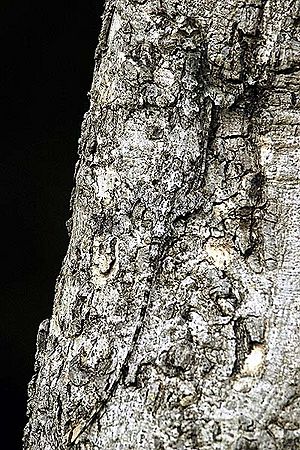Crypsis facts for kids

Bandipur National Park
Crypsis is a cool word used in ecology, which is the study of how living things interact with their environment. It basically means "hiding" or "being invisible." Crypsis is all about the clever ways animals avoid being seen or found by others.
Sometimes, an animal might even be right in front of you, but you don't realize what it is! This hiding trick can be used for two main reasons: either to protect an animal from predators (animals that hunt them), or to help a predator sneak up on its prey (the animals it hunts).
Animals use many different methods for crypsis. Some common ones include camouflage, being active only at night (called nocturnality), living underground, being see-through (transparency), and mimicry. Crypsis isn't just about sight; it can also involve hiding smells (olfactory) or sounds (auditory). Even eggs and the chemical signals called pheromones can be hidden!
Contents
How Animals Hide from Danger
Animals have developed amazing ways to stay hidden. These methods help them survive in the wild, whether they are trying to avoid being eaten or trying to catch a meal. Let's look at the main types of crypsis.
Simple Hiding: Out of Sight
The easiest way for an animal to use crypsis is to simply hide. This means moving to a place where it cannot be seen at all. Think of a rabbit diving into a bush or a fish swimming under a rock. They are completely out of sight from anything that might be looking for them.
Camouflage: Blending In
Camouflage is a super common and effective way animals use crypsis. With camouflage, an animal might be visible, but it blends in so well with its surroundings that it's hard to recognize. It's like they become part of the background.
Animals use different types of camouflage:
- Background matching: This is when an animal's colors and patterns match the colors and patterns of its environment. For example, a brown deer in a forest or a white polar bear in the snow.
- Disruptive coloration: This uses bold patterns, like stripes or spots, to break up an animal's outline. This makes it hard for a predator to see the animal's true shape. Think of a zebra's stripes in a herd.
- Countershading: Many animals are darker on their top side and lighter on their bottom side. When light hits them from above, the darker top blends with the shadows, and the lighter bottom looks darker, making them appear flat and less noticeable.
Mimicry: Looking Like Something Else
Mimicry is another clever form of crypsis where an animal looks like a different animal or even a plant. This can fool predators or prey. For example, some harmless snakes might have patterns that look like dangerous venomous snakes. This makes predators think twice before attacking.
A common type of mimicry is warning coloration. This is when an animal has bright, bold colors that tell predators, "I'm dangerous or taste bad!" Some harmless animals copy these warning colors to scare off predators, even though they aren't actually dangerous.
Images for kids
-
Camouflage allows animals like this disruptively-patterned spider to capture prey more easily.
See also
 In Spanish: Cripsis para niños
In Spanish: Cripsis para niños


